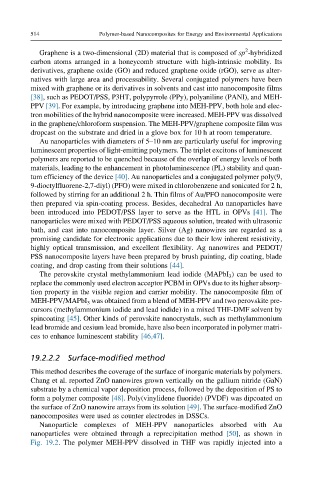Page 561 - Polymer-based Nanocomposites for Energy and Environmental Applications
P. 561
514 Polymer-based Nanocomposites for Energy and Environmental Applications
2
Graphene is a two-dimensional (2D) material that is composed of sp -hybridized
carbon atoms arranged in a honeycomb structure with high-intrinsic mobility. Its
derivatives, graphene oxide (GO) and reduced graphene oxide (rGO), serve as alter-
natives with large area and processability. Several conjugated polymers have been
mixed with graphene or its derivatives in solvents and cast into nanocomposite films
[38], such as PEDOT/PSS, P3HT, polypyrrole (PPy), polyaniline (PANI), and MEH-
PPV [39]. For example, by introducing graphene into MEH-PPV, both hole and elec-
tron mobilities of the hybrid nanocomposite were increased. MEH-PPV was dissolved
in the graphene/chloroform suspension. The MEH-PPV/graphene composite film was
dropcast on the substrate and dried in a glove box for 10 h at room temperature.
Au nanoparticles with diameters of 5–10 nm are particularly useful for improving
luminescent properties of light-emitting polymers. The triplet excitons of luminescent
polymers are reported to be quenched because of the overlap of energy levels of both
materials, leading to the enhancement in photoluminescence (PL) stability and quan-
tum efficiency of the device [40]. Au nanoparticles and a conjugated polymer poly(9,
9-dioctylfluorene-2,7-diyl) (PFO) were mixed in chlorobenzene and sonicated for 2 h,
followed by stirring for an additional 2 h. Thin films of Au/PFO nanocomposite were
then prepared via spin-coating process. Besides, decahedral Au nanoparticles have
been introduced into PEDOT/PSS layer to serve as the HTL in OPVs [41]. The
nanoparticles were mixed with PEDOT/PSS aqueous solution, treated with ultrasonic
bath, and cast into nanocomposite layer. Silver (Ag) nanowires are regarded as a
promising candidate for electronic applications due to their low inherent resistivity,
highly optical transmission, and excellent flexibility. Ag nanowires and PEDOT/
PSS nanocomposite layers have been prepared by brush painting, dip coating, blade
coating, and drop casting from their solutions [44].
The perovskite crystal methylammonium lead iodide (MAPbI 3 ) can be used to
replace the commonly used electron acceptor PCBM in OPVs due to its higher absorp-
tion property in the visible region and carrier mobility. The nanocomposite film of
MEH-PPV/MAPbI 3 was obtained from a blend of MEH-PPV and two perovskite pre-
cursors (methylammonium iodide and lead iodide) in a mixed THF-DMF solvent by
spincoating [45]. Other kinds of perovskite nanocrystals, such as methylammonium
lead bromide and cesium lead bromide, have also been incorporated in polymer matri-
ces to enhance luminescent stability [46,47].
19.2.2.2 Surface-modified method
This method describes the coverage of the surface of inorganic materials by polymers.
Chang et al. reported ZnO nanowires grown vertically on the gallium nitride (GaN)
substrate by a chemical vapor deposition process, followed by the deposition of PS to
form a polymer composite [48]. Poly(vinylidene fluoride) (PVDF) was dipcoated on
the surface of ZnO nanowire arrays from its solution [49]. The surface-modified ZnO
nanocomposites were used as counter electrodes in DSSCs.
Nanoparticle complexes of MEH-PPV nanoparticles absorbed with Au
nanoparticles were obtained through a reprecipitation method [50], as shown in
Fig. 19.2. The polymer MEH-PPV dissolved in THF was rapidly injected into a

